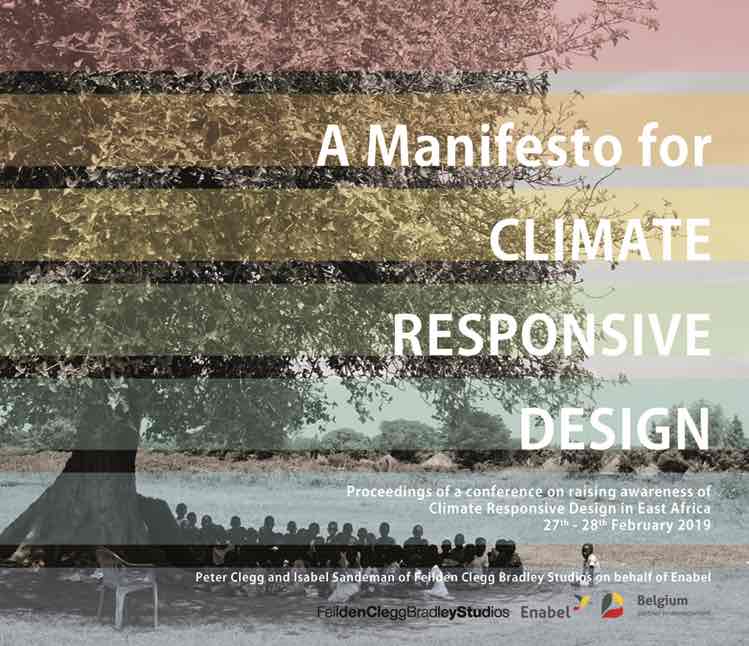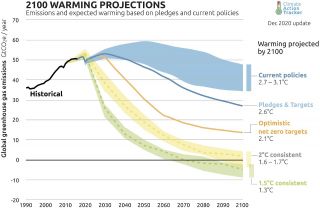
www.buildingsandcities.org/insights/commentaries/leadership-education-sustainability.html
Leadership is Critical in Mainstreaming Sustainability in Professional Education

An inspiring transformation of architectural education in the Global South shows a successful integration of sustainability.
Mark Olweny (University of Lincoln) comments on the B&C special issue EDUCATION & TRAINING: MAINSTREAMING ZERO CARBON. Leadership in Global South demonstrates the positive transformation of architectural education. The Uganda Martyrs University implemented a new curriculum to integrate sustainability into the architectural curricula. Change occurred due to staff dedication, commitment and stamina - although overcoming resistance at several levels was not easy.Introduction
The need to address climate change in architectural education has never been greater. However, transformation of courses to address it has been slow, and a possible hindrance to achieving the goals of the 2015 Paris Agreement. With Whitaker (2006) famously declaring "[a]rchitects are a lagging indicator for sustainable design", it is not difficult to see how big a role architectural education plays in any shift in the profession. Indeed, as is noted by (Shulman, 2005, p. 52), "if you wish to understand why professions develop as they do, study their nurseries, in this case, their forms of professional preparation."
For the most part, the professional preparation of architects is undertaken in a university setting, where it is subject to an array of rules and regulations, a means of ensuring confidence and quality in the educational processes leading to licensure. These codified boundaries have been criticised as promoting and reinforcing a status quo approach, producing graduates largely fit for existing practice (Milliner, 2000). This presents as a paradox in a transition to a zero-carbon future. While the consequences of doing nothing are known, any necessary changes create a daunting level of unknown-ness, with a consequential retreat into comfort zones thereby frustrating change (Randall, 2009). This is not helped by the reality that professional bodies, as key organisational stakeholders, are yet to provide clear direction of how professionals (or schools of architecture) could address climate change (Afroz, 2020). The lack of direction has ensured the persistence of status quo approaches, placing the impetus for change squarely on academic institutions, or specifically on the shoulders of individual academics willing to take on this risk. Nowhere is this more important than in the Global South, where the value of this leadership is critical in instigating and steering any transformation.
In the Buildings & Cities special issue "Education and Training: Mainstreaming Zero Carbon", Stevenson and Kwok (2020) lament the lack of representation of papers from the Global South. However, this should not be viewed as a lack of activities, with scholars having to prioritise engagements, a consequence of challenges that cannot be addressed here. The example of the Faculty of the Built Environment at Uganda Martyrs University (UMU) shows how leadership can transform an architectural programme to address sustainability and climate change. This transformation was largely derived from personal convictions that architectural education must go beyond its current professional mandate, to engage with broader responsibilities to society and the environment. In the context of East Africa, this challenge was two-fold. First, building awareness of the need to incorporate sustainability into architectural education, where it had not been considered. Second, building capacity to ensure staff and students could participate as part of a community of practice (Morton, 2012; Simpson, Janda, & Owen, 2020). UMU was in a fortunate position as pedagogical approaches in its school of architecture (founded in 2000) had not yet become entrenched.
Transforming architectural education
The transformation of UMU's architecture programme started in 2006 with an attempt to centre sustainability within the programme. This saw the development of a new programme sequence incorporating a Bachelor of Environmental Design (B.Envi.Des.) and Master of Architecture (M.Arch.)(Olweny, 2018). The goal was to integrate sustainability into all levels of the architecture curriculum. The undergraduate programme was redesigned to ensure students were adequately equipped with knowledge and skills to contribute to championing sustainability (even without completing the architecture professional degree). The Master of Architecture course was redesigned to ensure this next generation of architects would emerge as leaders in the field of sustainability and environmental design, premised on the notion that architectural education should induce "qualitative change" (Orr & Gao, 2011).
The challenges of the transformation process were immense: at the time, only two members of staff had experience in sustainability or environmental design, while none had any formal qualifications in higher education pedagogy. Most of the existing teaching approaches and content had been derived from the instructors' own educational experiences. In many cases this presented education as the mere transmission of preconceived and pre-digested knowledge. Therefore, it was necessary to address the capabilities of educators, reflecting on pedagogical approaches, sources of knowledge content, and assessment strategies among other things.
Changes to the programme were radical, involving significant pedagogical reforms. There was a shift from individual subject silos to an integrated model of teaching and learning, an approach also presented by Passe (2020). A new emphasis was also placed on the importance and value of teamwork and collaboration as a means to deliver sustainable projects. This brought together studio and theory components which previously had not connected various knowledge domains with architectural design.
Several hurdles existed in seeking to break from the status quo. Some students regarded the integrated program with suspicion as it had fewer lectures. Instead, students had to demonstrate learning in tutorials. Despite the provision of workshops to help staff with the transition, some were unwilling to adopt the new teaching approaches. Finally, although the programme exceeded existing validation requirements, the professional body presented numerous hurdles to the licensure of UMU's graduating students.
To date, UMU's programme is still the only split programme in Uganda. Its value is demonstrated by a growing demand for mid-level professionals who are conversant with sustainable design principles. Close to two decades since the changes were rolled out, there is a noticeable increase in interest in sustainable architecture, from client organisations, practice, and prospective students. This suggests two things. First, out of necessity, transformation cannot be easily delivered as a top-down approach given the long lead in times for legislative and regulatory change. Second, changes to regulations can only be driven by knowledgeable individuals able to initiate changes to rules and regulations. This requires the nurturing of expertise within schools of architecture, which in turn helps educate individuals who can then champion change at national and regional level, which reflects what Simpson et al. (2020) describe as a "middle-out perspective".

Conclusion
The changes implemented at UMU were only possible due to staff dedication and stamina to endure intense criticism for daring to think differently. The transformation of the programme was made possible by a steadfast commitment to change. There is no doubt seeking to implement such changes in an established school would be much more difficult, a consequence of entrenched attitudes and approaches. Another threat is a lack of continuity after a new approach is implemented. This can only be addressed by adequate succession planning - often not a priority for university administrations, a wicked problem affecting universities across the globe (Marco, 2020). While UMU did buffer itself against this in the short term, internal and external threats remain, which could adversely affect continued development and engagement with sustainable architecture.
Although there is still hope that there will be some directives from professional bodies to mandate higher educational standards and additional competences for entry to the profession, this is unlikely in the short term. Therefore, in the short term, change will be driven by individuals embracing an ethical agenda for an educational curriculum. This will ensure students are able to address both present and future challenges. Rules, regulations and policies will (eventually) change, but not without a critical mass of knowledgeable individuals who can effect and implement it.
References
Afroz, R. (2020). Developing a low-carbon architecture pedagogy in Bangladesh. Buildings and Cities, 1(1), 637-649. doi: 10.5334/bc.54
Clegg, P., & Sandeman, I. (Eds.). (2019). A Manifesto for Climate Responsive Design. Kampala: Enabel.
Marco, E. (2020, December 3). Commentary: A wicked higher education problem: Climate emergency requires brave leadership. Buildings and Cities. Retrieved from https://www.buildingsandcities.org/insights/commentaries/higher-education-climate.html
Milliner, L. (2000). Delight in transgression. In D. Nicol & S. Pilling (Eds.), Changing Architectural Education: Towards A New Professionalism (pp. 192-199). London: Spon Press.
Morton, J. (2012). Communities of practice in higher education: A challenge from the discipline of architecture. Linguistics and Education, 23(1), 100-111. doi:10.1016/j.linged.2011.04.002
Olweny, M. (2018). Introducing sustainability into an architectural curriculum in East Africa. International Journal of Sustainability in Higher Education, 19(6), 1131-1152. E-02-2018-0039
Orr, K., & Gao, Y. (2011). Becoming an architect: The role of work-based learning in architect training. Paper presented at the 7th International Conference on Researching Work and Learning, Shanghai, China.
Passe, U. (2020). A design workflow for integrating performance into architectural education. Buildings and Cities, 1(1), 565-578. doi: 10.5334/bc.48
Randall, R. (2009). Loss and climate change: The cost of parallel narratives. Ecopsychology, 1(3), 118-129. doi: 10.1089/eco.2009.0034
Shulman, L. S. (2005). Signature pedagogies in the professions. Daedalus, 134(3), 52-59. doi: 10.1162/0011526054622015
Simpson, K., Janda, K. B., & Owen, A. (2020). Preparing 'middle actors' to deliver zero-carbon building transitions. Buildings and Cities, 1(1), 610-624. doi: 10.5334/bc.53
Stevenson, F., & Kwok, A. (2020). Mainstreaming zero carbon: lessons for built-environment education and training. Buildings and Cities, 1(1), 687-696. doi: 10.5334/bc.84
UN-Habitat. (2016). Machakos Declaration for Sustainability in Architectural Education [Press release]
Whitaker, B. (2006, May 06). Architects are lagging indicators for sustainable design. The New York Times Online Edition. Retrieved from http://www.nytimes.com/2006/05/17/business/businessspecial2/17build.html?pagewanted=1&_r=2#
Latest Peer-Reviewed Journal Content
Acceptability of sufficiency consumption policies by Finnish households
E Nuorivaara & S Ahvenharju
Key factors for revitalising heritage buildings through adaptive reuse
É Savoie, J P Sapinski & A-M Laroche
Cooler streets for a cycleable city: assessing policy alignment
C Tang & J Bush
Understanding the embodied carbon credentials of modern methods of construction
R O'Hegarty, A McCarthy, J O'Hagan, T Thanapornpakornsin, S Raffoul & O Kinnane
The changing typology of urban apartment buildings in Aurinkolahti
S Meriläinen & A Tervo
Embodied climate impacts in urban development: a neighbourhood case study
S Sjökvist, N Francart, M Balouktsi & H Birgisdottir
Environmental effects of urban wind energy harvesting: a review
I Tsionas, M laguno-Munitxa & A Stephan
Office environment and employee differences by company health management certification
S Arata, M Sugiuchi, T Ikaga, Y Shiraishi, T Hayashi, S Ando & S Kawakubo
Spatiotemporal evaluation of embodied carbon in urban residential development
I Talvitie, A Amiri & S Junnila
Energy sufficiency in buildings and cities: current research, future directions [editorial]
M Sahakian, T Fawcett & S Darby
Sufficiency, consumption patterns and limits: a survey of French households
J Bouillet & C Grandclément
Health inequalities and indoor environments: research challenges and priorities [editorial]
M Ucci & A Mavrogianni
Operationalising energy sufficiency for low-carbon built environments in urbanising India
A B Lall & G Sethi
Promoting practices of sufficiency: reprogramming resource-intensive material arrangements
T H Christensen, L K Aagaard, A K Juvik, C Samson & K Gram-Hanssen
Culture change in the UK construction industry: an anthropological perspective
I Tellam
Are people willing to share living space? Household preferences in Finland
E Ruokamo, E Kylkilahti, M Lettenmeier & A Toppinen
Towards urban LCA: examining densification alternatives for a residential neighbourhood
M Moisio, E Salmio, T Kaasalainen, S Huuhka, A Räsänen, J Lahdensivu, M Leppänen & P Kuula
A population-level framework to estimate unequal exposure to indoor heat and air pollution
R Cole, C H Simpson, L Ferguson, P Symonds, J Taylor, C Heaviside, P Murage, H L Macintyre, S Hajat, A Mavrogianni & M Davies
Finnish glazed balconies: residents' experience, wellbeing and use
L Jegard, R Castaño-Rosa, S Kilpeläinen & S Pelsmakers
Modelling Nigerian residential dwellings: bottom-up approach and scenario analysis
C C Nwagwu, S Akin & E G Hertwich
Mapping municipal land policies: applications of flexible zoning for densification
V Götze, J-D Gerber & M Jehling
Energy sufficiency and recognition justice: a study of household consumption
A Guilbert
Linking housing, socio-demographic, environmental and mental health data at scale
P Symonds, C H Simpson, G Petrou, L Ferguson, A Mavrogianni & M Davies
Measuring health inequities due to housing characteristics
K Govertsen & M Kane
Provide or prevent? Exploring sufficiency imaginaries within Danish systems of provision
L K Aagaard & T H Christensen
Imagining sufficiency through collective changes as satisfiers
O Moynat & M Sahakian
US urban land-use reform: a strategy for energy sufficiency
Z M Subin, J Lombardi, R Muralidharan, J Korn, J Malik, T Pullen, M Wei & T Hong
Mapping supply chains for energy retrofit
F Wade & Y Han
Operationalising building-related energy sufficiency measures in SMEs
I Fouiteh, J D Cabrera Santelices, A Susini & M K Patel
Promoting neighbourhood sharing: infrastructures of convenience and community
A Huber, H Heinrichs & M Jaeger-Erben
New insights into thermal comfort sufficiency in dwellings
G van Moeseke, D de Grave, A Anciaux, J Sobczak & G Wallenborn
'Rightsize': a housing design game for spatial and energy sufficiency
P Graham, P Nourian, E Warwick & M Gath-Morad
Implementing housing policies for a sufficient lifestyle
M Bagheri, L Roth, L Siebke, C Rohde & H-J Linke
The jobs of climate adaptation
T Denham, L Rickards & O Ajulo
Structural barriers to sufficiency: the contribution of research on elites
M Koch, K Emilsson, J Lee & H Johansson
Disrupting the imaginaries of urban action to deliver just adaptation [editorial]
V Castán-Broto, M Olazabal & G Ziervogel
Nature for resilience reconfigured: global- to-local translation of frames in Africa
K Rochell, H Bulkeley & H Runhaar
How hegemonic discourses of sustainability influence urban climate action
V Castán Broto, L Westman & P Huang
Fabric first: is it still the right approach?
N Eyre, T Fawcett, M Topouzi, G Killip, T Oreszczyn, K Jenkinson & J Rosenow
Social value of the built environment [editorial]
F Samuel & K Watson
Understanding demolition [editorial]
S Huuhka
Data politics in the built environment [editorial]
A Karvonen & T Hargreaves



Latest Commentaries
Decolonising Cities: The Role of Street Naming
During colonialisation, street names were drawn from historical and societal contexts of the colonisers. Street nomenclature deployed by colonial administrators has a role in legitimising historical narratives and decentring local languages, cultures and heritage. Buyana Kareem examines street renaming as an important element of decolonisation.
Integrating Nature into Cities
Increasing vegetation and green and blue spaces in cities can support both climate change mitigation and adaptation goals, while also enhancing biodiversity and ecological health. Maibritt Pedersen Zari (Auckland University of Technology) explains why nature-based solutions (NbS) must be a vital part of urban planning and design.